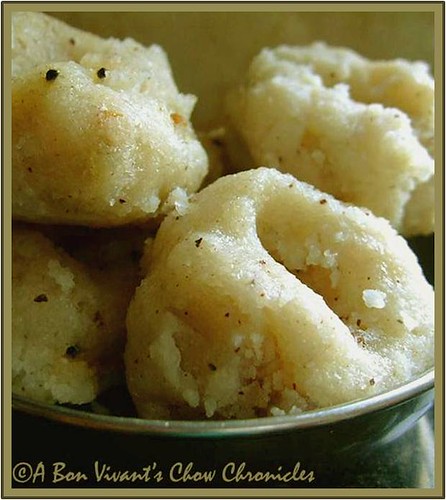
A simple and easy dumpling, Oondi is a always a quick fix breakfast in most Konkani households. The reason - it requires no prior overnight soaking of ingredients unlike idli or dosa. It is similar to a Modak or Kozhukattai, in that it contains rice and is steamed; however, on the contrary, Oondi has forever remained a savory dish.
Coconut is an integral ingredient of the Konkani cuisine, and is included in almost every meal of the day. The main dry ingredients for Oondi are coconut and semolina made from rice, in the ratio 1:2. Traditionally, both these ingredients are ground together with water into a thick batter. The batter is then seasoned with salt along with black mustard seeds, split black lentils, fenugreek seeds and cooked till it stiffens into a thick semi-dry paste. Small dumplings are made of this thick paste and steamed till done. Authentically, plantain leaves are used to steam these dumplings. But with the amenities that a modern kitchen provides, pressure cookers or idli cookers have now replaced the leaves. These dumplings are served hot with a drizzle of fresh coconut oil.
Though I like Oondi as is (strictly without the Coconut oil), I’ve always wanted to try it out with different ingredients. But never got around to do that till one Saturday morning. I decided to make Oondis for breakfast, only to realize that I was running low on the rice semolina. In no mood to drive to an Indian grocery, I decided to modify the recipe and use bulgur. I had previously attempted using regular wheat semolina in place of rice, but the outcome wasn’t anywhere close to appeasing.
Bulgur is made from parboiled, sun –dried wheat and is usually free of bran. Most often used to make Turkish pilafs and Lebanese Tabouleh; it has a nutty flavor and is considered more nutritious than rice. Personally, I find the texture of bulgur (soft white wheat variety) to be very close to the regular semolina and it was the only other alternative my kitchen pantry provided that morning.
So I combined rice semolina and bulgur in the ratio 2:1 for this “modified” version of the recipe. I used a pinch of powdered fenugreek instead of the regular seeds to avoid that burst of bitterness in the mouth. To retain the coarse texture and color of the rice semolina, I chose to grind bulgur with coconut to a fine paste, and then later on add the rice semolina towards the end. To avoid excessive oil, I dry roasted the mustard seeds, and using ½ teaspoon of oil sautéed the split black lentils (peel-off) for 2-3 mins till golden brown.

A close up showing the texture of the oondi.
Ingredients
1 cup Rice semolina
½ cup Bulgur
I buy the soft white wheat variety of bulgur from a local Turkish store
¼ cup Coconut, freshly grated
I have reduced the quantity of coconut, than what the recipe actually calls for.
You could use Coconut oil if you prefer to. I used regular Olive Oil.
½ teaspoon mustard seeds
½ teaspoon Split black lentil, peel–off (Udad dal)
A pinch of Fenugreek powder
Dry roast fenugreek till the seeds are warm and grind them to a fine powder
Salt to taste
Water
Method
Soak rice semolina in water for 15 minutes. Wash, strain and set aside.
Soak bulgur for 15 minutes in 1 cup of warm water.
Grind together soaked bulgur and coconut to a fine paste, with ¼ cup of water. Do not make the paste into a liquid by adding more water.
Add in the rice semolina and grind to a coarse consistency. Add salt to the paste.
Dry roast mustard seeds for 1-2 minutes. Set aside.
Heat oil in a pan, add black lentils and sauté for 2-3 minutes or till golden brown. Add the previously prepared paste , fenugreek powder and mustard seeds. Now to this mixture add 1½- 2 cups of water, and cook uncovered by stirring continuously, on medium flame, for 10-12minutes. Turn off the flame once done. Cooking is done when the mixture turns stiff.
Prepare dumplings or shape balls using the stiff paste. Make a depression at the top of each so that it cooks evenly and balances itself while steaming. Spread them on plantain leaves or in the container of a pressure cooker and steam covered for 12-15 minutes.
Serve hot with coconut chutney, Indian pickle or sambhar.
The Oondis with bulgur turn out yellow in color when compared to the original recipe. They are best eaten warm and can be stored for up to 12 hours. One cool thing to do would be to cut each of them into quarters, heat oil with chutney powder and toss the quarters in it. Make sure to toss well so that all the quarters are evenly coated.
These Oondis are my entry to Suganya's WBB- Healthy Eats.
10 comments:
I have never tried this recipe with bulgur. Sounds like a good alternative, will try this soon.
Eskay..Oondi looks great..donno hw it might b minus coco-oil! I now relate SK-coco-oil allergy !! :) Thks for sharing a lovely recipe!
Beautiful, Eskay. They are seemed, so low in fat too. Bulgur works surprisingly well in many Indian recipes. Thank you for sending two entries for WBB.
hi eskay!! do visit my blog..i have a surprise for you:)
Very innovative! Oondi is our oh-so-favorite Sunday morning breakfast.
Sure anonymous. Let me know if you liked it.
You got that right, Purnima:), me and coconut oil stay light years away:)
Glad you liked the recipe.
Thank you Suganya.
Thank U Saswati. I truly appreciate it.
Thank you Dee & Chai. Nice to learn that Oondi is yr favorite as well.
Post a Comment